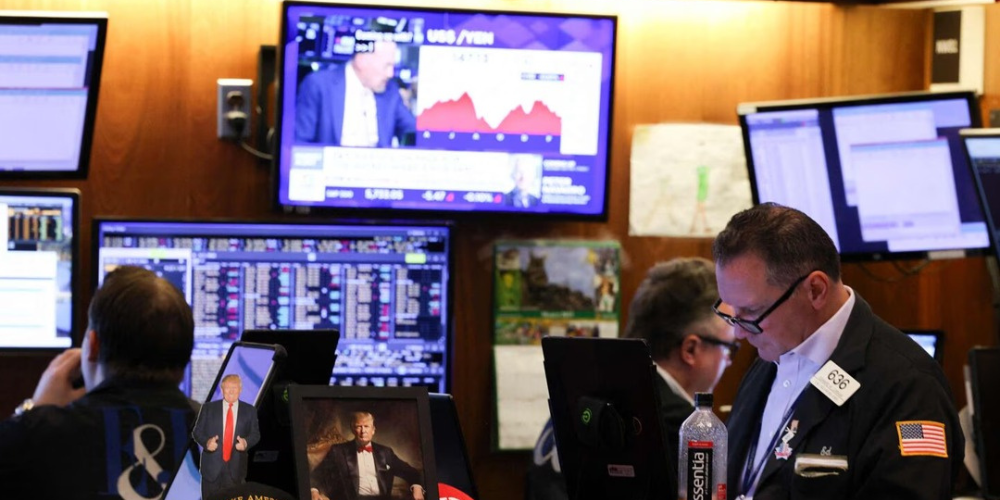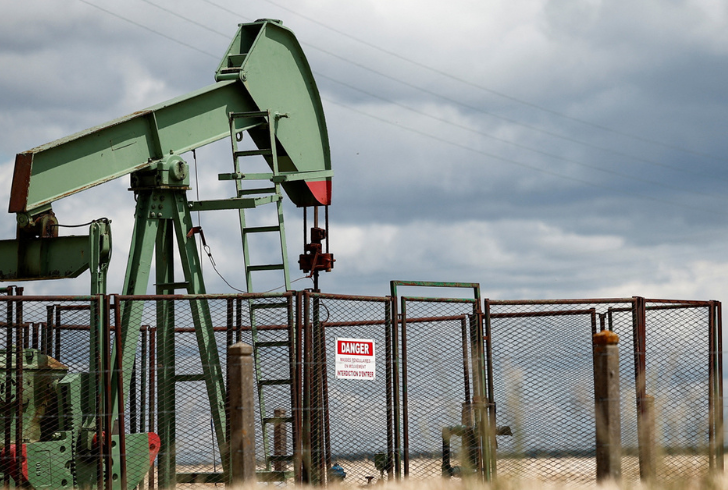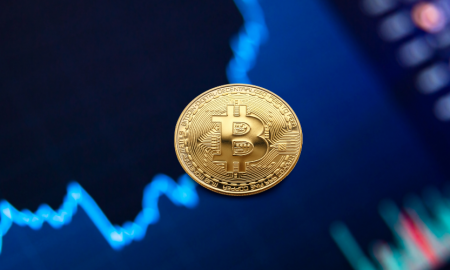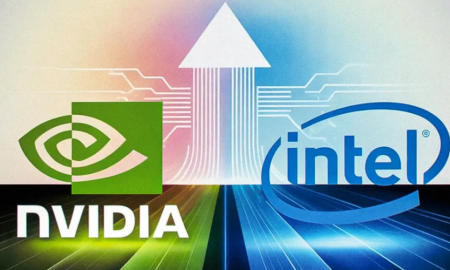
U.S. Stocks and Dollar Drop as Trump’s Tariff Moves Shake Wall Street

The U.S. stock market took a sharp hit Thursday after fresh updates from Washington sent traders into risk-off mode. With a 145% tariff on Chinese goods officially confirmed by the White House, investor confidence quickly evaporated, despite a brief surge the day before.
The result? Stocks tumbled, the dollar weakened, and economists signaled growing concerns over a possible recession.
U.S. Markets Retreat After Brief Rally
After a strong bounce earlier in the week, Thursday brought a wave of selling. The Dow Jones Industrial Average fell by 1,015 points, sliding 2.5% by the end of the day. At one point, the drop exceeded 2,100 points. The S&P 500 closed down 3.46%, while the Nasdaq Composite lost 4.31%. These declines followed what had been one of the best days for stocks in over a decade, making the turnaround even more jarring.
Although President Trump had scaled back his “reciprocal” tariffs for 90 days, investors were already reacting to the broader damage from existing trade policies. The U.S. economy is still absorbing the shock from steep tariffs, with the long-term impact becoming harder to ignore.
Dollar Drops and Gold Soars

Instagram | ndtvprofit | Gold soared to a record high amidst market uncertainty, signaling a shift away from riskier assets.
The U.S. dollar index, which measures the dollar against six major currencies, fell 1.7% on Thursday, touching its lowest point since early October. This decline in the dollar reflects growing concerns over the U.S. economy’s direction.
Meanwhile, gold prices surged to a record high, climbing past $3,170 per troy ounce. Gold often performs well in times of uncertainty, and this rally was the strongest since 1986. With both markets moving sharply, it’s clear investors are shifting away from riskier assets.
Volatility Spikes on Wall Street
Markets reacted to Trump’s temporary tariff pause with initial relief. Stock futures had ticked upward following the European Union’s decision to halt its own retaliatory tariffs, giving room for talks. Trump and Treasury Secretary Scott Bessent stated that over 70 nations were willing to discuss trade terms with the U.S.. The hope was that this break would lead to improved trade agreements.
But that optimism didn’t last long. The CBOE Volatility Index, or VIX — often called Wall Street’s “fear gauge” — jumped 40%, briefly surpassing the 50-point mark. That’s a level typically seen during extreme market stress.
Recession Concerns Stay High
Despite recent moves to reduce some tariffs, analysts aren’t convinced the economy is in the clear. Goldman Sachs noted that the likelihood of a U.S. recession remains unchanged. JPMorgan echoed that view, maintaining a 60% chance of both a domestic and global recession.
“There’s been too much economic pressure from multiple directions,” said Joe Brusuelas, chief economist at RSM. “All this delay does is push back what could be a series of new import taxes that are still on the table.”
Existing Tariffs Still in Effect
Several major tariffs are still active, adding more weight to the U.S. economy. These include:
– A universal 10% tariff that started on Saturday
– 25% tariffs on imported automobiles
– 25% tariffs on steel and aluminum
– Additional 25% duties on products from Canada and Mexico
More tariffs are expected soon, especially on items like pharmaceuticals, semiconductors, copper, and lumber.
China’s Response Remains Firm
The White House’s clarification confirmed that Chinese goods are now subject to a 145% total tariff. This includes the recently announced 125% levy, which builds on the existing 20%. That news triggered a fresh sell-off late Thursday morning.
Beijing, in response, enacted its own 84% tariffs on U.S. imports. While China has expressed willingness to engage in talks, officials made it clear that any future discussions must be based on mutual respect.
“If the U.S. wants dialogue, we are open. But pressure and threats will not work,” said a spokesperson from China’s Commerce Ministry.
Bond and Oil Markets Signal Trouble

Instagram | arynewstv | A significant drop in oil prices saw U.S. crude under $60 and Brent around $63.
Beyond stocks, other financial indicators also showed signs of stress. Treasury yields climbed sharply this week, a signal that bond prices are falling. The 10-year yield rose above 4.3% on Thursday, up from under 4% just days before.
“While the pause in tariffs helps a little, the overall direction hasn’t changed,” analysts from ING wrote in a note. “Volatility like this leaves a lasting impact on investor sentiment.”
Oil prices also dipped again. U.S. crude fell below $60 per barrel, levels not seen since 2021. Brent crude dropped around 4%, hovering near $63.
Global Markets Mixed as Europe Sees Relief
Despite the U.S. fallout, overseas markets saw a rebound. Asian indices like Japan’s Nikkei 225 and South Korea’s Kospi posted strong gains — rising over 9% and 6.6%, respectively. Hong Kong’s Hang Seng and Taiwan’s Taiex also recorded solid upticks.
European markets followed suit. The STOXX 600 rose 3.7%, while Germany’s DAX and France’s CAC climbed 4.5% and 3.8%. In the UK, the FTSE 100 added 3%.
European Commission President Ursula von der Leyen welcomed Trump’s tariff pause. “This step helps bring some calm to the global economic climate. Trade needs consistency to work efficiently,” she stated Thursday.
Billionaires Weigh In
Some major investors have spoken out about the tariff-driven chaos. Billionaire Ray Dalio applauded the temporary rollback, saying it was “a better approach” to tackling trade issues and economic imbalance. He added, “Hopefully, this signals a shift toward real negotiation — especially with China.”
Still, the broader outlook remains clouded by uncertainty. As the U.S. continues to juggle aggressive tariffs, ongoing policy changes, and global tensions, the markets are unlikely to find a stable footing anytime soon.
The U.S. markets are under pressure, with recent decisions adding to long-standing trade-related fears. While there’s hope that pauses in tariff implementation could lead to meaningful negotiations, the economic consequences are already visible. Investors are watching closely — and reacting fast — as the U.S. adjusts its position on global trade.
More in Investments
-
`
Will Bitcoin Crash to $0 or Hit $500K in a Decade?
Bitcoin’s future divides analysts into two extreme camps. Some see it becoming one of the most valuable financial assets in history....
October 12, 2025 -
`
Can Anyone Really Blame Mariah Carey for ‘Leaving’ the Real World?
Mariah Carey isn’t like the rest of us. From the moment she opens her mouth and that voice pours out, she...
October 10, 2025 -
`
Intel Invests in Nvidia, but Ratings Remain Unchanged
Intel’s stock jumped more than 30% after news broke that Nvidia poured $5 billion into the company. The rally sparked renewed...
October 5, 2025 -
`
Homeownership vs. Real Estate Investment: What’s Better?
Homeownership has long been seen as the American dream. But today, more people are asking: Is it really the smartest way...
October 3, 2025 -
`
Why the Armani Fashion Empire Is Set for an IPO
Giorgio Armani, one of the most iconic names in global fashion, left behind a detailed plan for the future of his...
September 27, 2025 -
`
Why Do Pokémon Cards Outperform the S&P 500 As an Investment?
Pokémon cards have outperformed the stock market by a mile. Since 2004, they have delivered a staggering 3,821% return, according to...
September 27, 2025 -
`
America’s Billionaires Get Older—Millennials Wait for Wealth Transfer
Many of today’s billionaires don’t match the youthful tech-founder image often portrayed. While names like Elon Musk, Sam Altman, and Mark...
September 21, 2025 -
`
Can President Trump Legally Fire Fed Governor Lisa Cook?
Lisa Cook is right in the middle of one of the most explosive legal battles in Washington. President Trump wants her...
September 20, 2025 -
`
Jeff Bezos’ Advice for Millennials Who Want Financial Success
Millennials today have grown up in a world where instant access to products and services is the norm. From two-day deliveries...
September 13, 2025















You must be logged in to post a comment Login